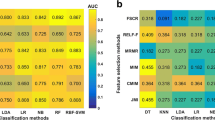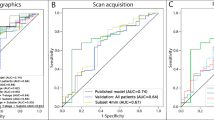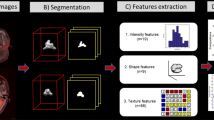Abstract
Objectives
To investigate the impact of parameter settings as used for the generation of radiomics features on their robustness and disease differentiation (nasopharyngeal carcinoma (NPC) versus chronic nasopharyngitis (CN) in FDG PET/CT imaging).
Methods
We studied 106 patients (69/37 NPC/CN, pathology confirmed), and extracted 57 radiomics features under different parameter settings. Robustness was assessed by the intra-class correlation coefficient (ICC). Logistic regression with leave-one-out cross validation was used to generate classification probabilities, and diagnostic performance was assessed by the area under the receiver operating characteristic curve (AUC).
Results
Varying averaging strategies and symmetry, 4/26 GLCM features showed poor range of pairwise ICCs of 0.02–0.98, while depicting good AUCs of 0.82–0.91. Varying distances, 5/26 GLCM features showed ICCs of 0.82–0.99 while corresponding AUCs were 0.52–0.91. 6/13 GLRLM features showed both high AUC (0.81–0.89) and high ICC (0.85–0.99) regarding to averaging strategies. 7/13 GLSZM features showed AUCs of 0.81–0.90 while having ICCs of 0.01–0.99 under different neighbourhoods. 2/5 NGTDM features showed AUCs of 0.81–0.85 while having ICCs of 0.19–0.89 for different window sizes. Differentiating a subset of NPC (stages I–II) form CN, both SumEntropy and SZLGE achieved significantly higher AUCs than metabolically active tumour volume (AUC: 0.91 vs. 0.72, p<0.01).
Conclusions
Radiomics features depicting poor absolute-scale robustness regarding to parameter settings can still lead to good diagnostic performance. As such, robustness of radiomics features should not be overemphasized for removal of features towards assessment of clinical tasks. For differentiating NPC from CN, some radiomics features (e.g. SumEntropy, SZLGE, LGZE) outperformed conventional metrics.
Key Points
• Poor robustness did not necessarily translate into poor differentiation performance.
• Absolute-scale robustness of radiomics features should not be overemphasized.
• Radiomics features SumEntropy, SZLGE and LGZE outperformed conventional metrics.






Similar content being viewed by others
Abbreviations
- AUC:
-
Area under the ROC curve
- CN:
-
Chronic nasopharyngitis
- 18F-FDG:
-
2-[18F]-fluoro-2-deoxy-D-glucose
- GLCM:
-
Grey level co-occurrence matrix
- GLRLM:
-
Grey level run length matrix
- GLSZM:
-
Grey level size zone matrix
- ICC:
-
Intra-class correlation coefficient
- LOOCV:
-
Leave-one-out cross validation
- MATV:
-
Metabolically active tumour volume
- NGTDM:
-
Neighbourhood grey tone difference matrix
- NPC:
-
Nasopharyngeal carcinoma
- ROC:
-
Receiver operating characteristic
- SUV:
-
Standardized uptake value
- TLG:
-
Total lesion glycolysis
References
Liu FY, Lin CY, Chang JT et al (2007) 18F-FDG PET can replace conventional work-up in primary M staging of nonkeratinizing nasopharyngeal carcinoma. J Nucl Med 48:1614–1619
O'Donnell HE, Plowman PN, Khaira MK, Alusi G (2008) PET scanning and Gamma Knife radiosurgery in the early diagnosis and salvage "cure" of locally recurrent nasopharyngeal carcinoma. Br J Radiol 81:e26–e30
Ng SH, Chan SC, Yen TC et al (2009) Staging of untreated nasopharyngeal carcinoma with PET/CT: comparison with conventional imaging work-up. Eur J Nucl Med Mol Imaging 36:12–22
Wu H, Wang Q, Wang M, Zhen X, Zhou W, Li H (2011) Preliminary study of 11C-choline PET/CT for T staging of locally advanced nasopharyngeal carcinoma: comparison with 18F-FDG PET/CT. J Nucl Med 52:341–346
King AD, Ma BB, Yau YY et al (2008) The impact of 18F-FDG PET/CT on assessment of nasopharyngeal carcinoma at diagnosis. Br J Radiol 81:291–298
Strauss LG (1996) Fluorine-18 deoxyglucose and false-positive results: a major problem in the diagnostics of oncological patients. Eur J Nucl Med 23:1409–1415
van Waarde A, Cobben DC, Suurmeijer AJ et al (2004) Selectivity of 18F-FLT and 18F-FDG for differentiating tumor from inflammation in a rodent model. J Nucl Med 45:695–700
Hustinx R, Smith RJ, Benard F et al (1999) Dual time point fluorine-18 fluorodeoxyglucose positron emission tomography: a potential method to differentiate malignancy from inflammation and normal tissue in the head and neck. Eur J Nucl Med 26:1345–1348
Wahl RL (2008) Principles and practice of PET and PET/CT. Lippincott Williams & Wilkins, Philadelphia
Gerlinger M, Rowan AJ, Horswell S et al (2012) Intratumor heterogeneity and branched evolution revealed by multiregion sequencing. New Engl J Med 366:883–892
Parekh V, Jacobs MA (2016) Radiomics: a new application from established techniques. Expert Rev Precis Med Drug Dev 1:207–226
Lambin P, Rios-Velazquez E, Leijenaar R et al (2012) Radiomics: Extracting more information from medical images using advanced feature analysis. Eur J Cancer 48:441–446
Aerts HJ, Velazquez ER, Leijenaar RT et al (2014) Decoding tumour phenotype by noninvasive imaging using a quantitative radiomics approach. Nat Commun 5:4006
Mu W, Chen Z, Liang Y et al (2015) Staging of cervical cancer based on tumor heterogeneity characterized by texture features on 18F-FDG PET images. Phys Med Biol 60:5123–5139
Yip SS, Coroller TP, Sanford NN, Mamon H, Aerts HJ, Berbeco RI (2016) Relationship between the temporal changes in positron-emission-tomography-imaging-based textural features and pathologic response and survival in esophageal cancer patients. Front Oncol 6:72
Coroller TP, Agrawal V, Narayan V et al (2016) Radiomic phenotype features predict pathological response in non-small cell lung cancer. Radiother Oncol 119:480–486
Wu W, Parmar C, Grossmann P et al (2016) Exploratory study to identify radiomics classifiers for lung cancer histology. Front Oncol 6:71
Soussan M, Orlhac F, Boubaya M et al (2014) Relationship between tumor heterogeneity measured on FDG-PET/CT and pathological prognostic factors in invasive breast cancer. PLoS One 9:e94017
Lovinfosse P, Janvary ZL, Coucke P et al (2016) FDG PET/CT texture analysis for predicting the outcome of lung cancer treated by stereotactic body radiation therapy. Eur J Nucl Med Mol Imaging 43:1453–1460
Tixier F, Hatt M, Valla C et al (2014) Visual versus quantitative assessment of intratumor 18F-FDG PET uptake heterogeneity: prognostic value in non-small cell lung cancer. J Nucl Med 55:1235–1241
El NI, Grigsby P, Apte A et al (2009) Exploring feature-based approaches in PET images for predicting cancer treatment outcomes. Pattern Recognit 42:1162–1171
Win T, Miles KA, Janes SM et al (2013) Tumor heterogeneity and permeability as measured on the CT component of PET/CT predict survival in patients with non-small cell lung cancer. Clin Cancer Res 19:3591–3599
Cheng NM, Fang YH, Lee LY et al (2015) Zone-size nonuniformity of 18F-FDG PET regional textural features predicts survival in patients with oropharyngeal cancer. Eur J Nucl Med Mol Imaging 42:419–428
Tixier F, Groves AM, Goh V et al (2014) Correlation of intra-tumor 18F-FDG uptake heterogeneity indices with perfusion CT derived parameters in colorectal cancer. PLoS One 9:e99567
Soufi M, Kamali-Asl A, Geramifar P, Rahmim A (2017) A Novel Framework for Automated Segmentation and Labeling of Homogeneous Versus Heterogeneous Lung Tumors in [F-18]FDG-PET Imaging. Mol Imaging Biol 19:456–468
Vallieres M, Freeman CR, Skamene SR, El Naqa I (2015) A radiomics model from joint FDG-PET and MRI texture features for the prediction of lung metastases in soft-tissue sarcomas of the extremities. Phys Med Biol 60:5471–5496
Lambin P, Leijenaar R, Deist TM et al (2017) Radiomics: the bridge between medical imaging and personalized medicine. Nat Rev Clin Oncol14:749-762
Aerts HJ (2016) The Potential of Radiomic-Based Phenotyping in Precision Medicine: A Review. JAMA Oncol 2:1636–1642
Gillies RJ, Kinahan PE, Hricak H (2016) Radiomics: Images Are More than Pictures, They Are Data. Radiology 278:563–577
Yip SS, Aerts HJ (2016) Applications and limitations of radiomics. Phys Med Biol 61:R150–R166
Galavis PE, Hollensen C, Jallow N, Paliwal B, Jeraj R (2010) Variability of textural features in FDG PET images due to different acquisition modes and reconstruction parameters. Acta Oncol 49:1012–1016
van Velden FHP, Kramer GM, Frings V et al (2016) Repeatability of radiomic features in non-small-cell lung cancer [18F]FDG-PET/CT studies: Impact of reconstruction and delineation. Mol Imaging Biol 18:788–795
Doumou G, Siddique M, Tsoumpas C, Goh V, Cook GJ (2015) The precision of textural analysis in 18F-FDG-PET scans of oesophageal cancer. Eur Radiol 25:2805–2812
Hatt M, Tixier F, Cheze LRC, Pradier O, Visvikis D (2013) Robustness of intratumour 18F-FDG PET uptake heterogeneity quantification for therapy response prediction in oesophageal carcinoma. Eur J Nucl Med Mol Imaging 40:1662–1671
Leijenaar RT, Nalbantov G, Carvalho S et al (2015) The effect of SUV discretization in quantitative FDG-PET Radiomics: the need for standardized methodology in tumor texture analysis. Sci Rep 5:11075
Lu L, Lv W, Jiang J et al (2016) Robustness of radiomic features in [11C]choline and [18F]FDG PET/CT imaging of nasopharyngeal carcinoma: impact of segmentation and discretization. Mol Imaging Biol 18:935–945
Hatt M, Tixier F, Pierce L, Kinahan PE, Le Rest CC, Visvikis D (2017) Characterization of PET/CT images using texture analysis: the past, the present... any future? Eur J Nucl Med Mol Imaging 44:151–165
Haralick RM, Shanmugam K, Dinstein I (1973) Textural features for image classification. IEEE Trans Syst Man Cyb. SMC-3:610–621
Soh L, Tsatsoulis C (1999) Texture Analysis of SAR Sea Ice Imagery Using Gray Level Co-Occurrence Matrices. IEEE T Geosci Remote 37:780–795
Metser U, Jhaveri KS, Murphy G, Halankar J (2015) Multiparameteric PET-MR assessment of response to neoadjuvant chemoradiotherapy in locally advanced rectal cancer: PET, MR, PET-MR and tumor texture analysis: A pilot study. Adv Mol Imaging 5:49–60
Roy A, Warbey V, Ferner R, O’Doherty M, Marsden P (2012) Feature based differentiation of benign, malignant and atypical neurofibroma in FDG-PET scans. J Nucl Med 53:2256
Rahmim A, Salimpour Y, Jain S et al (2016) Application of texture analysis to DAT SPECT imaging: Relationship to clinical assessments. Neuroimage Clin 12:e1–e9
Gelzinis A, Verikas A, Bacauskiene M (2007) Increasing the discrimination power of the co-occurrence matrix-based features. Pattern Recogn 40:2367–2372
Rahmim A, Salimpour Y, Blinder S, Klyuzhin I, Sossi V (2016) Optimized haralick texture quantification to track Parkinson’s disease progression from DAT SPECT images. J Nucl Med 57:428
Nanni L, Brahnam S, Ghidoni S, Menegatti E, Barrier T (2013) Different approaches for extracting information from the co-occurrence matrix. PLoS One 8:e83554
Hatt M, Majdoub M, Vallieres M et al (2015) 18F-FDG PET uptake characterization through texture analysis: investigating the complementary nature of heterogeneity and functional tumor volume in a multi-cancer site patient cohort. J Nucl Med 56:38–44
Yu H, Caldwell C, Mah K, Mozeg D (2009) Coregistered FDG PET/CT-based textural characterization of head and neck cancer for radiation treatment planning. IEEE Trans Med Imaging 28:374–383
Delbeke D, Coleman RE, Guiberteau MJ et al (2006) Procedure guideline for tumor imaging with 18F-FDG PET/CT 1.0. J Nucl Med 47:885–895
Jiang J, Wu H, Huang M et al (2015) Variability of Gross Tumor Volume in Nasopharyngeal Carcinoma Using 11C-Choline and 18F-FDG PET/CT. PLoS One 10:e131801
Stone M (1974) Cross-validatory choice and assessment of statistical predictions. J R Stat Soc. 36:111–147
DeLong ER, DeLong DM, Clarke-Pearson DL (1988) Comparing the areas under two or more correlated receiver operating characteristic curves: a nonparametric approach. Biometrics 44:837–845
Shiri I, Rahmim A, Ghaffarian P, Geramifar P, Abdollahi H, Bitarafan-Rajabi A (2017) The impact of image reconstruction settings on 18F-FDG PET radiomic features: multi-scanner phantom and patient studies. Eur Radiol 27:4498–4509
Bailly C, Bodet-Milin C, Couespel S et al (2016) Revisiting the robustness of PET-based textural features in the context of multi-centric trials. PLoS One 11:e159984
Orlhac F, Boughdad S, Nioche C, Alberini JL, Soussan M, Buvat I (2017) An original approach to deal with multi-center variability of PET textural features. J Nucl Med 58:506
Lin C, Bradshaw T, Perk T, Harmon S, Liu G, Jeraj R (2015) Repeatability of [18F]-NaF PET imaging biomarkers for bone lesions: A multicenter study. Med Phys 42:3587
Busson P (2013) Nasopharyngeal carcinoma keys for translational medicine and biology. Landes Bioscience and Springer Science+Business Media, Austin
Funding
This work was supported by the National Natural Science Foundation of China under grants 61628105, 81501541, U1708261, 61471188, 81271641, the National key research and development program under grant 2016YFC0104003, the Natural Science Foundation of Guangdong Province under grants 2016A030313577, and the Program of Pearl River Young Talents of Science and Technology in Guangzhou under grant 201610010011.
Author information
Authors and Affiliations
Corresponding authors
Ethics declarations
Guarantor
The scientific guarantor of this publication is Dr. Lijun Lu.
Conflict of interest
The authors of this manuscript declare no relationships with any companies whose products or services may be related to the subject matter of the article.
Statistics and biometry
No complex statistical methods were necessary for this paper.
Informed consent
Written informed consent was waived by the Institutional Review Board.
Ethical approval
Institutional Review Board approval was obtained.
Methodology
• retrospective
• diagnostic study
• performed at one institution
Electronic supplementary material
ESM 1
(DOC 554 kb)
Rights and permissions
About this article
Cite this article
Lv, W., Yuan, Q., Wang, Q. et al. Robustness versus disease differentiation when varying parameter settings in radiomics features: application to nasopharyngeal PET/CT. Eur Radiol 28, 3245–3254 (2018). https://doi.org/10.1007/s00330-018-5343-0
Received:
Revised:
Accepted:
Published:
Issue Date:
DOI: https://doi.org/10.1007/s00330-018-5343-0




